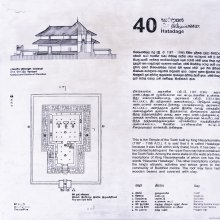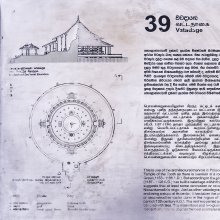Haras: 4 definitions
Introduction:
Haras means something in Hinduism, Sanskrit, biology. If you want to know the exact meaning, history, etymology or English translation of this term then check out the descriptions on this page. Add your comment or reference to a book if you want to contribute to this summary article.
Images (photo gallery)
Biology (plants and animals)
Source: Google Books: CRC World Dictionary (Regional names)Haras in Arabic is the name of a plant defined with Faidherbia albida in various botanical sources. This page contains potential references in Ayurveda, modern medicine, and other folk traditions or local practices It has the synonym Acacia mossambicensis Bolle (among others).
Example references for further research on medicinal uses or toxicity (see latin names for full list):
· A Study of the Kanuri Language. (1937)
· Dictionary of the Hausa Language. (1899)
· Edwards’s Botanical Register
· Bull. Int. Group for Study of Mimosoideae (1977)
· Life among the Hereros in Africa. (1922)
· Journal of Ethnopharmacology (1987)
If you are looking for specific details regarding Haras, for example chemical composition, diet and recipes, pregnancy safety, extract dosage, side effects, health benefits, have a look at these references.

This sections includes definitions from the five kingdoms of living things: Animals, Plants, Fungi, Protists and Monera. It will include both the official binomial nomenclature (scientific names usually in Latin) as well as regional spellings and variants.
Languages of India and abroad
Sanskrit dictionary
Source: Cologne Digital Sanskrit Dictionaries: Cappeller Sanskrit-English DictionaryHaras (हरस्).—1. [neuter] grip; draught (in drinking, also = drink, beverage); vigour, energy, strength, power; poss. harasvant & harasvin.
--- OR ---
Haras (हरस्).—2. [neuter] anger, wrath.
Source: Cologne Digital Sanskrit Dictionaries: Monier-Williams Sanskrit-English Dictionary1) Haras (हरस्):—[from hara] a n. a grasp, grip, [Atharva-veda]
2) [v.s. ...] a draught, drink, beverage, [Ṛg-veda; Atharva-veda]
3) [v.s. ...] flame, fire ([according to] to some also ‘anger’, ‘fury’), [ib.] cf. [Greek] θέρος.
4) b etc. See [column]2.
[Sanskrit to German]
Sanskrit, also spelled संस्कृतम् (saṃskṛtam), is an ancient language of India commonly seen as the grandmother of the Indo-European language family (even English!). Closely allied with Prakrit and Pali, Sanskrit is more exhaustive in both grammar and terms and has the most extensive collection of literature in the world, greatly surpassing its sister-languages Greek and Latin.
See also (Relevant definitions)
Starts with (+27): Harasadanem, Harasadisa Ananem, Harasakha, Harasala, Harasalu, Harasamaya, Harasamayi, Harasamudra, Harasana, Harasanga, Harasaranem, Harasaur, Harasaura, Harase, Harasevaka, Harasha, Harashakala, Harashasana, Harashaya, Harashekhara.
Ends with: Apaharas, Bharas, Charas, Jharas, Kharas, Sabharas, Safed-charas, Saras, Shipharas, Sudharas, Takdharas, Trinabindusharas, Uccasharas, Urdhvabharas, Viduharas, Viluharas, Vishvabharas.
Full-text: Harasvin, Harasvat, Apaharas, Viduharas, Harasvant, Acita, Simharaja, Samanvahara.
Relevant text
Search found 11 books and stories containing Haras; (plurals include: Harases). You can also click to the full overview containing English textual excerpts. Below are direct links for the most relevant articles:
Rig Veda (translation and commentary) (by H. H. Wilson)
Rig Veda 5.2.1 < [Sukta 2]
Pallava period (Social and Cultural History) (by S. Krishnamurthy)
Neck Ornaments (Kanthabhushana) < [Chapter 4 - Material Culture of the People]
Necklace (Hara) < [Chapter 4 - Material Culture of the People]
Conclusion (Material Culture) < [Chapter 5 - Conclusion]
Temples in and around Madurantakam (by B. Mekala)
Sri Venkateswarar Temple < [Chapter 4 - Prominent Temples in Madurantakam Taluk]
Kodandarama or Kothandarama Perumal Temple—Madurantakam < [Chapter 4 - Prominent Temples in Madurantakam Taluk]
Atcheeswarar Temple at Acharapakkam < [Chapter 4 - Prominent Temples in Madurantakam Taluk]
Jainism in Odisha (Orissa) (by Ashis Ranjan Sahoo)
Jaina Antiquities in Prachi Valley (Cuttack) < [Chapter 3: Survey of Jaina Antiquities in Odisha]
Sahitya-kaumudi by Baladeva Vidyabhushana (by Gaurapada Dāsa)
Text 5.12 < [Chapter 5 - Second-rate Poetry]
Later Chola Temples (by S. R. Balasubrahmanyam)
Temples in Palayarai < [Chapter IV - Temples of Vikrama Chola’s Time]
Temples in Nandalur (Nandaluru) < [Chapter II - Temples of Kulottunga I’s Time]


